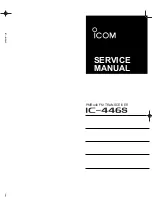
SCS-1R Installation Guide
Digital Monitoring Products
29
Appendix
Appendix
Host Communication Formats
Serial 1 Messages
The Serial 1 message format is based on fixed positions for information content and a constant character string
length. Serial 1 Messages are only sent to the Host Automation Computer when an alarm panel sends the message
in the Serial 1 message format.
Serial 3 Messages
The Serial 3 message format is available when an XRSuper6, XR20 (version 201 and higher), XT30, XR40, XT50,
XR200, XR2400F, XR200-485, XR100 and XR500 Series panel is communicating to an SCS-1R Receiver. Serial 3 allows
16-character user names to be sent to the Host Automation Computer. Additionally, the Serial 3 format design
provides for the addition of new information in later upgrades without the need to immediately upgrade the SCS-
1R Receiver or the Host Automation Computer software.
Serial 3 Messages are only sent when an alarm panel sends the message in the Serial 3 Message format and the
Serial 3 Messages option in the Host Configuration programming of the SCS-1R Receiver is programmed YES. If the
receiver is programmed NO for Serial 3 Messages, all messages are automatically converted to the Serial 1 format
and then sent to the Host Automation Computer. Refer to the SCS-1R Host Communication Specification for Serial
1 and Serial 3 messages.
Network Connection
What is Data Network Communication?
A major difference between DMP Data Network and dialer accounts is the panel ability to use digital networks,
such as computer data networks like the Internet, instead of standard analog phone lines.
NET (Network) is not a polled format. Using NET, the panel sends supervision messages when programmed and
receives acknowledgments for the messages from the receiver in much the same way a dialer account does.
The data format is different using NET communication. Past messages sent by DMP panels have always been in
Synchronous Data Link Control (SDLC) packet format. Messages from panels using NET communication send in
DMP NET format. Previously, this format was used only by the DMP SCS-1R Receiver to communicate with Host
automation computers.
Now, by selecting Network (NET) as the Communication Type in the panel, and Network (NET) as a the Line
Configuration in the SCS-1R Receiver, alarm and system messages from subscriber accounts can be accepted by
the receiver and sent along to the automation system without the need to convert any data.
Configuring the Receiver Line
From the SCS-1R Receiver, scroll to Configure System in the LCD menu. Select NET for the particular line (port on
the SCS-1062) to be used during NET communication. The selected line is now able to accept incoming messages
from panels using the Data Network (NET) report format.
Although the receiver does not poll a panel using Network communication on a regular basis, the receiver
responds to each message the panel sends with an Acknowledgment signal.
When NET is selected, the SCS-100 Line Card for the configured line is not used for communication. Instead, a
DMP SCS-101 Network Interface Card is used to connect directly to the digital network. The SCS-1062 port must
be configured for NET operation by resetting its jumpers. See Figure 1. Any port can be configured for SDLC
communication or NET digital network communication.
When changing between SDLC and NET, move only jumpers Q through Z and aa through dd.






































